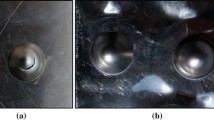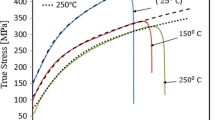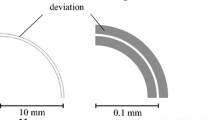Abstract
This paper presents a theoretical, numerical and experimental analysis of the allowable (maximum) deep drawing height (DDH) of rectangular cups made of steel. In particular, a new expression to calculate the allowable DDH of rectangular deep drawing, based on the equivalent diameter concept and the volume conservation principle, is proposed and compared with those theoretical expressions currently available in the literature. Finite element method simulations together with experimental data taken from a set of 20 industrial steel parts are used to evaluate the accuracy of each theoretical expression. The results have shown that the new expression has superior precision than those existing in the literature.
Similar content being viewed by others
References
Groover MP (2007) Fundamentals of modern manufacturing: Materials, processes and systems, 3rd edn. Wiley, New York
Seah KHW, Lee KS (1987) Parametric studies in deep drawing. Society of Manufacturing Engineering, Technical Paper MF87-232, Dearborn
Goto Y, Shiraishi M, Miyashita M, Matsuyama S (1996) Deep drawing characteristics for cylindrical cups of sheet titanium, stainless steel and cold rolled carbon steel. Proc 5th Int Conf Technol Plast 2:823–826
Vahdat V, Santhanam S, Chun YW (2006) A numerical investigation on the use of drawbeads to minimize ear formation in deep drawing. J Mater Process Technol 176:70–76
Allen SJ, Mahdavian SM (2008) The effect of lubrication on die expansion during the deep drawing of axisymmetrical steel cups. J Mater Process Technol 199:102–107
Kim H, Sung JH, Sivakumar R, Altan T (2007) Evaluation of stamping lubricants using the deep drawing test. Int J Mach Tools Manuf 47:2120–2132
Shahani AR, Salehinia I (2008) Analysis of wear in deep-drawing process of a cylindrical cup. J Mater Process Technol 200:451–459
El-Wakil SD, Kamal MNEM, Darwish A-H (1980) Mechanics of the square box forming operation of aluminum blanks. Sheet Met Ind 57:679–689
Majlessi SA, Lee D (1993) Deep drawing of square-shaped sheet metal parts, part 2: experimental study. Trans ASME Manuf Proc 115:102–106
Gavas M, Izciler M (2006) Design and application of blank holder system with spiral spring in deep drawing of square cups. J Mater Process Technol 171(2):274–282
Demirci HI, Esner C, Yasar M (2008) Effect of the blank holder force on drawing of aluminum alloy square cup: theoretical and experimental investigation. J Mater Process Technol 206:152–160
Saxena Ravindra K, Dixit PM (2010) Prediction of flange wrinkling in deep drawing process using bifurcation criterion. J Manuf Process 12:19–29
Leyu W, Daxin E (2006) Numerical simulation analysis of variable BHF drawing of rectangular cup on curve blank-holder. Mod Manuf Eng 2:73–74
Lin CT, Kwan CT (2009) Application of abductive network and FEM to predict the optimal blank contour of an elliptical cylindrical cup from deep drawing. J Mater Process Technol 209(3):1351–1361
Chen FK, Huang TB, Chang CK (2003) Deep drawing of square cups with magnesium alloy AZ31 sheets. Int J Mach Tools Manuf 43(15):1553–1559
Wen T, Daxin E (2004) Application of FEM on the study of material flowing deformation rule in the process of rectangular cup drawing. Mod Manuf Eng 4:40–42
Khelifaa M, Oudjeneb M (2008) Numerical damage prediction in deep-drawing of sheet metals. J Mater Process Technol 200:71–76
Daxin E, Takaji M (2006) Drawing and stress analysis test of rectangular cup of metal sheet. China Mech Eng 17:1195–1197
Gavas M, Izciler M (2007) Effect of blank holder gap on deep drawing of square cups. J Mater Des 28(5):1641–1646
Daxin E, Mizuno T, Li Z (2008) Stress analysis of rectangular cup drawing. J Mater Process Technol 205:469–476
Wan M, Yang YY, Li SB (2001) Determination of the limiting drawing coefficient in the deep drawing of conical cups. J Mater Process Technol 114:114–117
Onder E, Tekkaya AE (2008) Numerical simulation of various cross sectional workpieces using conventional deep drawing and hydroforming technologies. Int J Mach Tools Manuf 48:532–542
Lang L, Li T, An D, Chi C, Nielsen KB, Danckert J (2009) Investigation into hydromechanical deep drawing of aluminum alloy-complicated components in aircraft manufacturing. Materials Science and Engineering, A 499(1–2):320–324
Lange K (ed) (1985) Handbook of metal forming. Mc. Graw Hill, New York
Smith DA, Bakerjian R (1990) Die design handbook, 3rd edn. Society of Manufacturing Engineers, Dearborn
Society of Manufacturing Engineers (ed) (1998) Tool and manufacturing engineers handbook. Volume 2: Forming, Society of Manufacturing Engineers Dearbord
Marciniak Z. (2002) Mechanics of metal forming. Butterworth-Heinemann.
Kobayashi S, Oh S-I, Altan T (1989) Metal forming and the finite-element method. Oxford University Press. Inc, New York
Makinouchi A, Nakamachi E, Onate E, Wagoner RH (eds) (1993) Verification of simulation with experiments. Proceedings of the Numisheet 1993. Second International Conference on Numerical Simulation of 3D Sheet Metal Forming Process, Ishera, Japan, August 31–September 2
Hill R. (1948) A theory of yielding and plastic flow of anisotropic metals. Proceedings of the Royal Society of London
Zhang HW, Xu WL, Onate E, Di SL, Thomson PF (2002) Quadratic programming method in numerical simulation of metal forming process. Comput Methods Appl Mech Engr 191:5555–5578
Author information
Authors and Affiliations
Corresponding author
Rights and permissions
About this article
Cite this article
Medellín-Castillo, H.I., de J. García-Zugasti, P., de Lange, D.F. et al. Analysis of the allowable deep drawing height of rectangular steel parts. Int J Adv Manuf Technol 66, 371–380 (2013). https://doi.org/10.1007/s00170-012-4331-9
Received:
Accepted:
Published:
Issue Date:
DOI: https://doi.org/10.1007/s00170-012-4331-9




